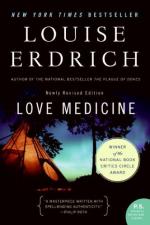|
This section contains 4,962 words (approx. 17 pages at 300 words per page) |

|
SOURCE: Smith, Jeanne Rosier. “Comic Liberators and World-Healers: The Interwoven Trickster Narratives of Louise Erdrich.” In Writing Tricksters: Mythic Gambols in American Ethnic Literature, pp. 71-110. Berkeley: University of California Press, 1997.
In the following excerpt, Smith investigates Erdrich's use of the Native American trickster archetype in Love Medicine.
The trickster's constant chatterings and antics remind us that life is endlessly narrative, prolific and openended.
—William Hynes Mythical Trickster Figures
From the first publication of Love Medicine in 1984, tricksters have played a central and pervasive role in Louise Erdrich's fiction.1 A family of tricksters wanders through Love Medicine, Tracks, and The Bingo Palace. The very existence of such a trickster “family” as Erdrich's rewrites a major tenet of a trickster tradition in which the trickster always travels alone. Erdrich's novels transgress trickster traditions in other ways as well, revising traditional myths, and in the cases of Fleur and Lulu...
|
This section contains 4,962 words (approx. 17 pages at 300 words per page) |

|


